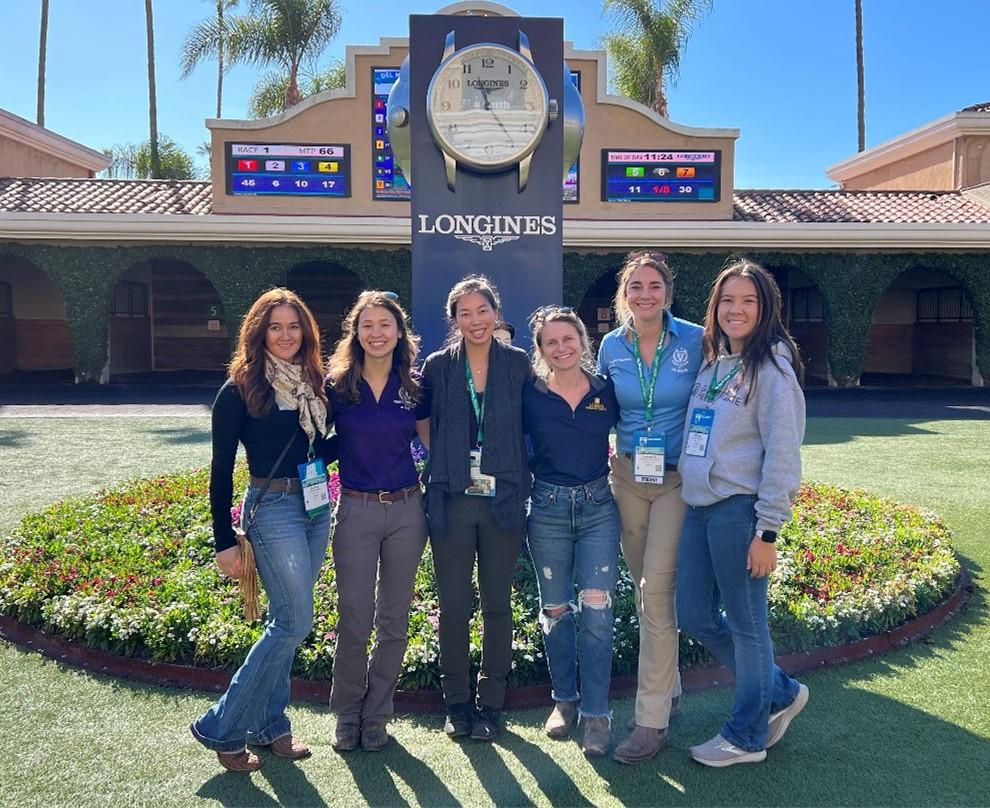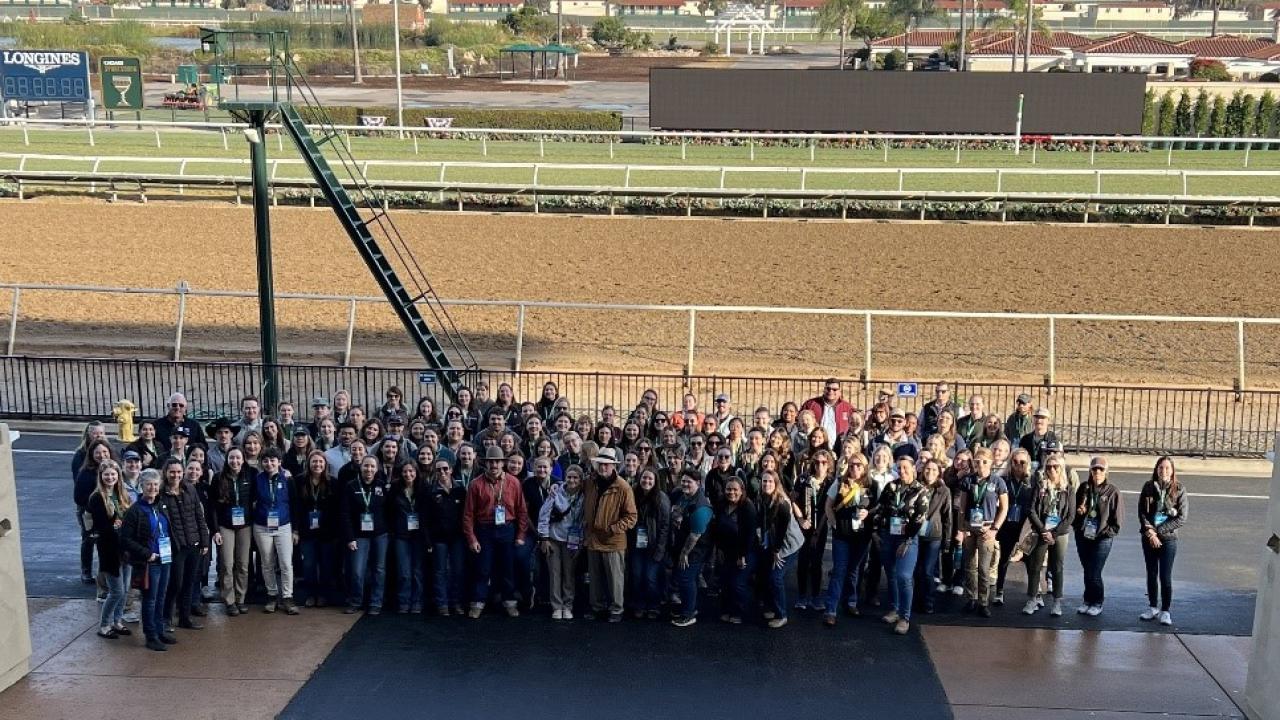
Veterinary Students Receive Warm Welcome at Del Mar Racetrack
More than 100 veterinary students attending the American Association of Equine Practitioners (AAEP) Convention in San Diego got a unique glimpse behind the racetrack at Del Mar Thoroughbred Club on one of the final race days of the fall meet. From morning workouts through afternoon races, students learned firsthand about the important roles racetrack veterinarians play in ensuring the safety and welfare of these equine athletes. Several equine veterinarians involved in racetrack practice were on hand to share their experiences, advice, and above all, passion for their careers.
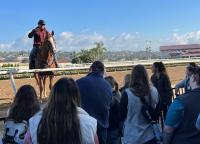
“Many veterinary students, including myself, did not grow up with exposure to the racetrack,” said California Horse Racing Board (CHRB) Official Veterinarian Alina Vale. “After I was introduced to the track, I knew I wanted to devote my career to these amazing athletes. Practicing veterinarians and regulatory veterinarians at the track can have a profound impact on racehorse welfare and safety.”
The unique opportunity of the proximity of the AAEP Convention location to Del Mar, and the fact that the track was still running its fall meet, made this opportunity possible.
“The goal was awareness of the racing industry, its relationship with veterinary medicine, and the multiple opportunities for a career on the track as a private practitioner or regulatory veterinarian,” said California Equine Medical Director Jeffrey Blea.
Initially expected to attract 20 to 30 participants, overwhelming interest saw attendance soar to more than 110 students from veterinary schools across the United States, and even internationally.
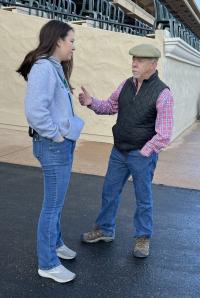
“When Del Mar Thoroughbred Club (DMTC) President and Chief Operating Officer Josh Rubinstein and Executive Vice President of Racing and Industry Relations Tom Robbins were made aware of the numbers of interested students, their response was, ‘Bring them all. We would love to have them!’,” reflected Blea.
One of the most famous racetracks in the world, DMTC began welcoming racing enthusiasts in 1937. From Hollywood celebrities to local residents, visitors have cheered on famous horses including Seabiscuit, Cigar, and Zenyatta, and renowned jockeys such as William (Bill) Shoemaker, Gary Stevens, and Victor Espinoza. Although the facility has changed with the times, the rich history and lingering air of old Hollywood glamor made it an undeniably unique setting for many of the students to experience their first horseraces.
“On behalf of the California Thoroughbred racing industry, I was thrilled at the response we received from the veterinary students that attended our race day at Del Mar,” said Rubinstein. “A special thank you to Dr. Blea, for his hard work on making the event such a success. We hope some of these future veterinarians will choose the exciting and rewarding career path of Thoroughbred racing in California.”
A sunny Southern California morning welcomed the students to the storied track where they began the day watching workouts and chatting with fellow students. A number of small groups also formed to talk with veterinarians about their career paths. Along the rail, Vale and outrider Enrique Alférez, aboard his pony horse Scarface, explained the role of outriders and their horses in keeping racehorses and jockeys safe.
From there, the students ventured to the receiving barn, where regulatory veterinarians Drs. Brent Cassady and Dana Stead outlined pre-race veterinary examinations and the role of veterinarians in the safety program. Topics included how many horses a regulatory veterinarian sees in a day, how much time they spend evaluating each horse, and the importance of communicating clearly and plainly with trainers. A few trainers brought horses in for race day examinations so the students could appreciate how veterinarians look for changes in factors such as stride length, hip symmetry, and head carriage that can be signs of potential issues.
“The thing that most stood out to me was the sheer volume of people tasked with safeguarding the health of the horse,” said Fred Holcomb, a third-year veterinary student at Texas A&M University. “From the head steward monitoring for crop violations during training to the veterinarians doing the pre-race evaluations, it was clear that the equine athletes’ safety was a priority.”
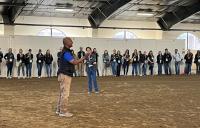
Chief Official Veterinarian for the CHRB Dr. Tim Grande and Official Veterinarian Dr. Nolton Pattio rounded out the discussion of veterinarians’ race day responsibilities, testing procedures, how horses are placed on the veterinarian’s list and how they are removed from the list, and special considerations for horses in claiming races.
“When you practice on the track, you work together with the regulators,” said Pattio. “Safety and integrity are a collective effort.”
“The opportunity to tour the Del Mar racetrack was the perfect occasion to learn about a portion of the equine industry that I was not familiar with,” said Kenzie Jones, a second-year veterinary student at Kansas State University. “They walked us through the rigorous protocols of how horses are evaluated before and after their races. I was very impressed when the veterinarians shared that all recorded evaluations of the horses are logged into a nationwide system so that the information will follow them when they travel to different locations.”
After a tour of the barn area, students were treated to lunch in a suite with prime seats for the afternoon races. Private practitioners and officials, including representatives from the Stronach Group, Kentucky Horse Racing Commission, Horseracing Integrity and Safety Authority (HISA), New York Racing Association, San Luis Rey Downs, and more welcomed them and shared opportunities for externships and other learning experiences, along with encouragement for career paths in racetrack medicine.
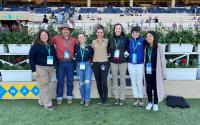
“There is such a need for these types of veterinarians, but it's so hard to imagine what their day-to-day would be like without talking to the professionals who practice it,” said Rachel Akin, a second-year veterinary student at Mississippi State University. “I'm not sure I would have gotten an experience like this anywhere else. It is such a beautiful track, and it was a great spot to watch my first races ever!”
The second race of the afternoon - which ended in an exciting photo finish - was named for the AAEP event and some of the scholarship recipients had the opportunity to stand in the winner’s circle for the official photo.
“It has been really meaningful to come out with other students because I’m always talking about how I want to go into racetrack medicine,” said AAEP scholarship recipient and fourth-year UC Davis veterinary student Megan Elcombe. “I think it is invaluable for us to be here, see what it’s about, and not just have the perception of what’s in the media but actually talk to the practitioners that are working so hard to make this a better industry.”
Given the success of this event, similar opportunities will likely be available to veterinary students in the future, either with the AAEP Convention or through regional opportunities for AAEP student chapters to travel to local tracks.
“This event was a means to break down barriers, let the students interact, and realize this is something they could possibly explore, and even go into after graduation,” said Blea. “We are grateful to Del Mar for hosting and for their commitment to the veterinary profession.”
# # #
